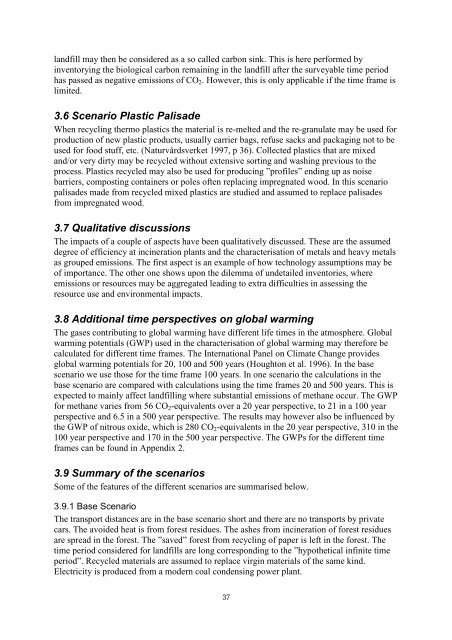Life Cycle Assessments of Energy From Solid Waste (PDF)
Life Cycle Assessments of Energy From Solid Waste (PDF)
Life Cycle Assessments of Energy From Solid Waste (PDF)
Create successful ePaper yourself
Turn your PDF publications into a flip-book with our unique Google optimized e-Paper software.
landfill may then be considered as a so called carbon sink. This is here performed by<br />
inventorying the biological carbon remaining in the landfill after the surveyable time period<br />
has passed as negative emissions <strong>of</strong> CO 2 . However, this is only applicable if the time frame is<br />
limited.<br />
3.6 Scenario Plastic Palisade<br />
When recycling thermo plastics the material is re-melted and the re-granulate may be used for<br />
production <strong>of</strong> new plastic products, usually carrier bags, refuse sacks and packaging not to be<br />
used for food stuff, etc. (Naturvårdsverket 1997, p 36). Collected plastics that are mixed<br />
and/or very dirty may be recycled without extensive sorting and washing previous to the<br />
process. Plastics recycled may also be used for producing ”pr<strong>of</strong>iles” ending up as noise<br />
barriers, composting containers or poles <strong>of</strong>ten replacing impregnated wood. In this scenario<br />
palisades made from recycled mixed plastics are studied and assumed to replace palisades<br />
from impregnated wood.<br />
3.7 Qualitative discussions<br />
The impacts <strong>of</strong> a couple <strong>of</strong> aspects have been qualitatively discussed. These are the assumed<br />
degree <strong>of</strong> efficiency at incineration plants and the characterisation <strong>of</strong> metals and heavy metals<br />
as grouped emissions. The first aspect is an example <strong>of</strong> how technology assumptions may be<br />
<strong>of</strong> importance. The other one shows upon the dilemma <strong>of</strong> undetailed inventories, where<br />
emissions or resources may be aggregated leading to extra difficulties in assessing the<br />
resource use and environmental impacts.<br />
3.8 Additional time perspectives on global warming<br />
The gases contributing to global warming have different life times in the atmosphere. Global<br />
warming potentials (GWP) used in the characterisation <strong>of</strong> global warming may therefore be<br />
calculated for different time frames. The International Panel on Climate Change provides<br />
global warming potentials for 20, 100 and 500 years (Houghton et al. 1996). In the base<br />
scenario we use those for the time frame 100 years. In one scenario the calculations in the<br />
base scenario are compared with calculations using the time frames 20 and 500 years. This is<br />
expected to mainly affect landfilling where substantial emissions <strong>of</strong> methane occur. The GWP<br />
for methane varies from 56 CO 2 -equivalents over a 20 year perspective, to 21 in a 100 year<br />
perspective and 6.5 in a 500 year perspective. The results may however also be influenced by<br />
the GWP <strong>of</strong> nitrous oxide, which is 280 CO 2 -equivalents in the 20 year perspective, 310 in the<br />
100 year perspective and 170 in the 500 year perspective. The GWPs for the different time<br />
frames can be found in Appendix 2.<br />
3.9 Summary <strong>of</strong> the scenarios<br />
Some <strong>of</strong> the features <strong>of</strong> the different scenarios are summarised below.<br />
3.9.1 Base Scenario<br />
The transport distances are in the base scenario short and there are no transports by private<br />
cars. The avoided heat is from forest residues. The ashes from incineration <strong>of</strong> forest residues<br />
are spread in the forest. The ”saved” forest from recycling <strong>of</strong> paper is left in the forest. The<br />
time period considered for landfills are long corresponding to the ”hypothetical infinite time<br />
period”. Recycled materials are assumed to replace virgin materials <strong>of</strong> the same kind.<br />
Electricity is produced from a modern coal condensing power plant.<br />
37
















